| 2. Transport in Region
Areas The role of transport in creating highly attractive region areas1 is very important. There are cases where public transportation facilities such as railways, buses and taxis have previously played a certain role in rural areas, but generally, private motor vehicles have been the key mode of transport. |
Changes in the Number of Trips Taken Annually Per Person |
|
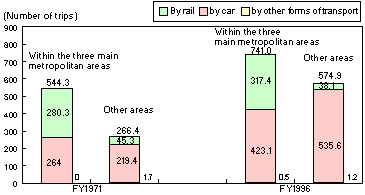 |
|
| Source:Ministry of Transport "Compiled from a survey regarding the flow of passenger between regions" |
| The number of trips being made by passenger both within the three main metropolitan areas and in other regions has greatly increased in the last 25 years. In regions outside the three main metropolitan areas, the number of trips made by train has decreased. However, as a result of the increase in the number of trips by car, the total number of trips has risen sharply. The difference between the total number of trips taken in the three main metropolitan areas and trips taken in other regions has narrowed. |
| Cooperative management between transport operators
should fundamentally conduct the maintenance and construction of these
public transportation facilities, but national and local authorities must
offer the required support in line with definite policy aims of modernization
and revitalization. Consider the following points regarding private motor vehicles - The percentage of people holding a drivers license has noticeably increased, and the number of people who cannot use a private motor vehicle has rapidly decreased. (Although the percentage of women in the elderly age bracket possessing a drivers license is comparatively low, the dramatic upswing in the number of men with a driving license means that the overall number of households that have access to private motor vehicles has increased). - Senior citizens in rural areas do not rely greatly on forms of public transportation such as buses. - In rural areas, negative impacts accompanying an increase in the use of private motor vehicles - such as traffic congestion - are minimal. Judging from these conditions, it can be expected that the role played by the highly convenient private motor vehicle will only continue to increase. |
Changes in the Number of People Aged 16 and Over Without a Motor Vehicle's License |
|||
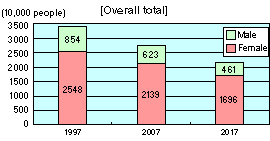 |
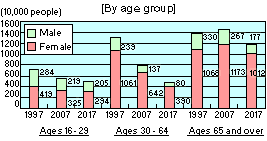 |
||
| In 1997, approximately
one person in three aged 16 years or older did not possess a driver's
license. Due to the increase in the overall percentage of people holding
a driver's license, the proportion of people not holding a driver's license
is expected to drop to one in four in 2007 and to one in five in 2017. Although the proportion of women aged 65 and over who hold a driver's license is comparatively low, the proportion of men in the same age bracket who do possess a license will increase dramatically from around three in five in 1997, to three in four in 2007, and to around seven in eight in 2017. As a result, the overall number of households that have access to private motor vehicles is expected to increase. |
| So how should we address the problem of securing transportation for people who cannot use a private motor vehicle in areas where it is difficult to establish public transportation operations? It is necessary, based on forward-looking judgment by regional authorities, to respond to the needs of citizens and regional conditions, and to select an appropriate option from among an array of versatile modes of transport (such as shuttle buses, share-ride taxi buses, school buses and welfare buses for elderly and disabled passenger). The state will support transport services that contribute to a broad array of social exchanges. In order to sustain transport systems in rural society, it is important to develop the necessary infrastructure, including the latest information technology and public support systems. |
Modes of Transport That Have Become a Part of the Local Community
|
|||
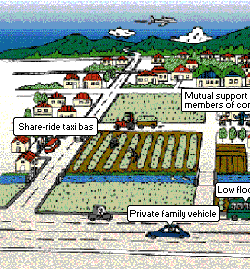 |
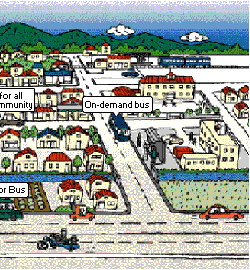 |
||
| In both rural areas and sightseeing spots, there
are many occasions when traffic problems will arise as a result of a large
number of private motor vehicles driving in a confined area. In response
to these traffic problems, it is necessary to promote a steady demand
for sightseeing based on a spread of responses to the increase in people's
leisure time, and to take action to facilitate transportation systems
in response to local conditions and requirements. Also, it is necessary from the perspective of securing the national minimum to preserve air and sea routes to the remote islands located far from the Japanese mainland that lack the possibility of utilizing private transport facilities. |
Establishing and Maintaining Air Routes to Japan's Remote Islands |
| The air routes to Japan's remote islands (as of April 1, 2000) | |
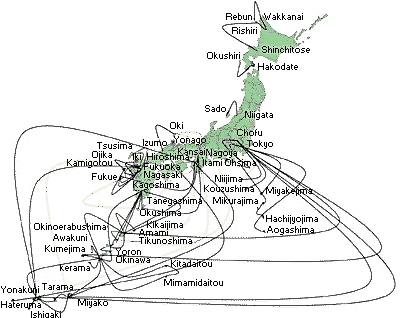 |
Air Hokkaido
Co., Ltd. (3) Asahi Shin Airlines (1) Air Nippon (20) New Central Airlines Co., Ltd. (4) Japan Air Commuter Co., Ltd. (18) Nagasaki Airlines Co., Ltd. (6) Japan Air System Co., Ltd. (5) Ryukyu Air Commuter Co., Ltd. (11) Japan Trans Ocean Air (9) Toho Air Service Co., Ltd. (Helicopters) (5) A total of 74 routes (excluding 7 double track routes) The dotted lines show routes no longer in service 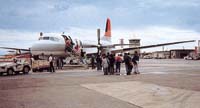 Air service to one of Japan's remote islands (Photo taken at Ishigaki airport in Okinawa) |
|
|
PREVIOUS |
|
TOP |
|